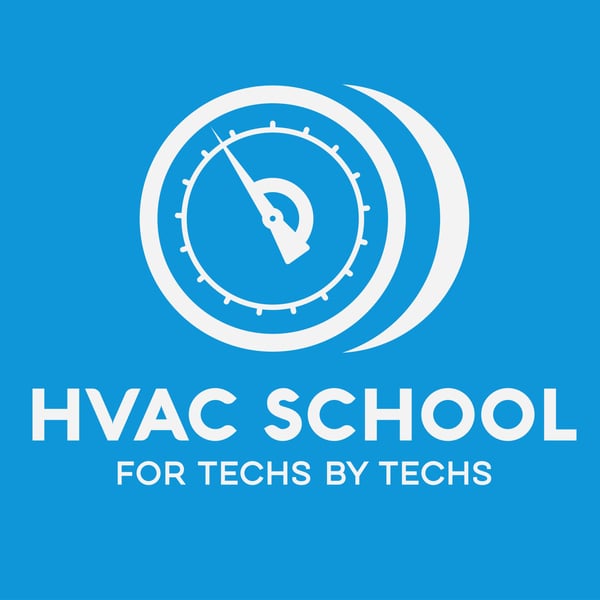Preventing Slugging & Flooding w/ Copeland
HVAC School - For Techs, By Techs
Bryan Orr
4.8 • 985 Ratings
🗓️ 27 March 2025
⏱️ 34 minutes
🧾️ Download transcript
Summary
In this episode of the HVAC School Podcast, host Bryan welcomes Jeff from Copeland to discuss the critical topic of flooding and slugging in compressors. Jeff, calling in from frigid Minnesota (at negative 19°F), explains the differences between these harmful conditions and how they can damage compressor systems.
The conversation begins by differentiating between flood back and flooded starts. Flood back occurs during system operation when control of the evaporator is lost, often due to airflow issues. Flooded starts happen after the system has been off, when refrigerant migrates to the compressor oil. Both conditions can lead to slugging - when liquid refrigerant enters the compression chamber, causing immediate damage to valves and internal components. While flood back and flooded starts may cause gradual damage over time, slugging can break compressor components instantly.
Jeff emphasizes that proper superheat levels are essential for compressor health, with most Copeland compressors requiring about 20 degrees of superheat at the compressor suction line. The discussion covers various preventative measures, including pump down systems, properly installed crankcase heaters, and the importance of maintaining appropriate refrigerant charge. Jeff notes that many technicians incorrectly assume crankcase heaters are only needed in cold climates, when they're actually crucial for preventing refrigerant migration in any environment.
Key Topics Covered:
- The difference between flood back (during operation) and flooded starts (when the system restarts)
- How slugging causes immediate damage to compressors while flooding causes progressive damage
- The importance of maintaining proper superheat (typically 20 degrees at the compressor)
- Common causes of flood back: dirty filters, improper airflow, duct problems, and incomplete defrosting
- How refrigerant is attracted to compressor oil even in vapor form
- Prevention strategies: pump down systems, proper crankcase heater installation and verification
- The impact of line sizing and total refrigerant charge on system reliability
- Why compressors are designed for vapor-in/vapor-out operation, not liquid handling
- The importance of consulting OEM literature and Copeland resources when troubleshooting
- Why it's critical to identify and fix the underlying cause before replacing a failed compressor
Have a question that you want us to answer on the podcast? Submit your questions at https://www.speakpipe.com/hvacschool.
Purchase your tickets or learn more about the 6th Annual HVACR Training Symposium at https://hvacrschool.com/symposium.
Subscribe to our podcast on your iPhone or Android.
Subscribe to our YouTube channel.
Check out our handy calculators here or on the HVAC School Mobile App for Apple and Android
Transcript
Click on a timestamp to play from that location
| 0:00.0 | The HVAC School Podcast is made possible by these great partners. |
| 0:08.1 | Refrigeration technologies and their Viper aerosol coil cleaner for condensers and evaporators. |
| 0:15.0 | If you don't know, the Viper aerosol cleaner is a foaming cleaner that you can spray into a coil with its really powerful pin spray. |
| 0:22.6 | It has a strong degreasing capability in a convenient package. |
| 0:27.6 | It's safe to use with rinsing or no rinse, so there's zero need to bring a bulky pump sprayer into the house for an evaporative coil cleaning or in many refrigeration applications. |
| 0:38.3 | And like we mentioned, it works on our evaporators and condensers. |
| 0:41.3 | Find out more at refrigetec.com. |
| 0:45.3 | UEI and UEI test instruments. |
| 0:49.3 | Have you taken a look at the UEI combustion analyzers? |
| 0:52.3 | They have a diverse product line with combustion analyzers |
| 0:55.9 | that keep your customers safe in any application, residential, commercial, or industrial. |
| 1:01.6 | The C-165-plus, write that down. Unless you're driving, don't rent it down if you're driving. |
| 1:06.9 | That would be unsafe, and that's the whole point of this is safety but the C-165 plus works for |
| 1:11.2 | residential and commercial equipment allowing you to verify the safety of combustion and commission |
| 1:16.7 | equipment seamlessly they can come with or without the NOx sensor in the C-165 plus N |
| 1:25.9 | products it's the NOx sensor N for NOx, nitric oxide. And there's a version of the C-165 |
| 1:33.3 | plus for oil fired equipment, including boilers. That's the C-165 plus oil. See how easy they make it. |
| 1:41.3 | It also comes with a smoke pump tester. It's all backed by the UEI Service Plus |
| 1:45.2 | Guarantee. That's where the rubber meets the road. It's super easy to get top-not service that keeps |
| 1:50.1 | your tools in top working order. You can book your annual recertification online within one year |
| 1:56.1 | of purchase or last service. UEI will provide the shipping label and pay for shipping both ways through |
| 2:02.6 | UPS and extend the warranty for one year for up to 10 years. |
... |
Please login to see the full transcript.
Disclaimer: The podcast and artwork embedded on this page are from Bryan Orr, and are the property of its owner and not affiliated with or endorsed by Tapesearch.
Generated transcripts are the property of Bryan Orr and are distributed freely under the Fair Use doctrine. Transcripts generated by Tapesearch are not guaranteed to be accurate.
Copyright © Tapesearch 2025.

